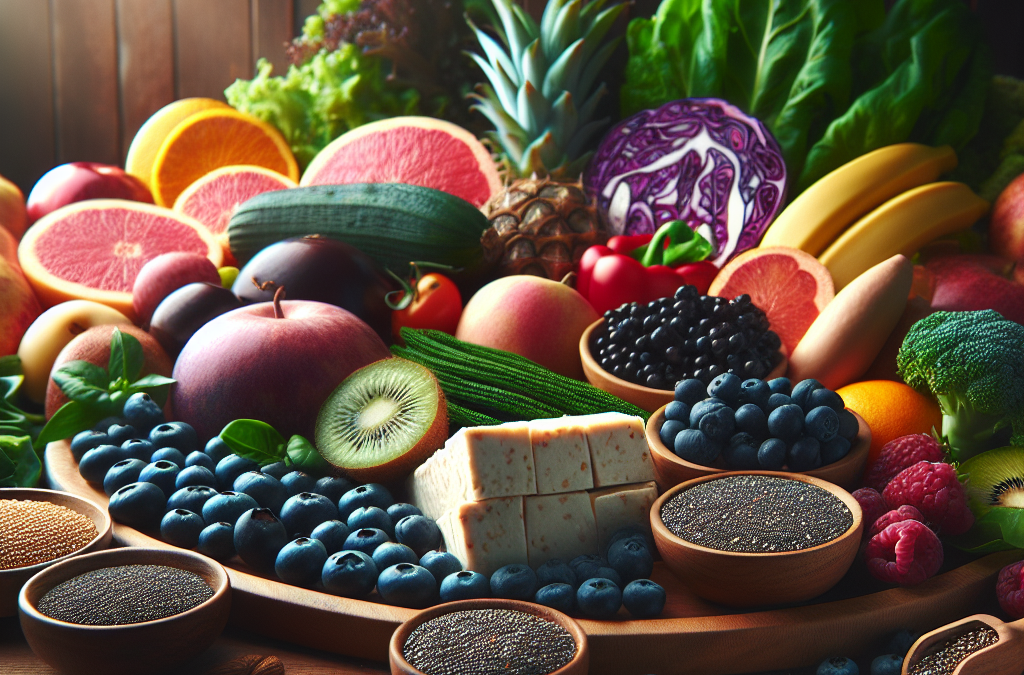Leafy Greens
Power of Nutrients
When I think about the powerhouse of nutrition, leafy greens come to mind immediately. Spinach, kale, and collard greens are all packed with essential nutrients like vitamin K, folate, and magnesium. These minerals play substantial roles in keeping our blood vessels healthy and functioning properly.
Consuming a variety of leafy greens daily can amplify your body’s ability to maintain a healthy blood pressure and reduce your risk of various cardiovascular diseases. Incorporating these into salads or smoothies makes it easy to get in your greens.
For someone like me, who loves to mix things up, experimenting with different leafy greens can keep meals exciting. Toss in some arugula for a peppery punch or freshly chopped spinach into a savory omelet. You’ll be amazed by how versatile they can be!
Antioxidant Benefits
What I’ve learned is that many leafy greens are brimming with antioxidants, which help combat oxidative stress in our bodies. This oxidative stress can contribute to inflammation and a host of health issues, including stroke risk.
Incorporating leafy greens like swiss chard or bok choy into my meals has not only added vibrant color but also beneficial compounds that fight inflammation. It’s a win-win!
I remember the first time I’d added kale to my smoothie. The intense green color felt alive, and knowing I was fueling my body with anti-inflammatory properties made the experience even better.
Delicious and Versatile Cooking
Another reason I love leafy greens is their versatility in the kitchen. You can sauté them, throw them into soups, or enjoy them raw. The flavors can range from mild to robust, making them suitable for any dish.
I often find myself adding a handful of spinach or kale to pasta dishes, stir-fries, or even as a topping on homemade pizzas. It’s incredible how such a simple addition can enhance nutrition while also adding a delightful texture to my favorite meals.
Plus, let’s not forget how easy it is to grow your own leafy greens! Having fresh vegetables right from the garden is not only rewarding but a great way to enjoy fresh, nutrient-packed greens.
Fatty Fish
Omega-3 Fatty Acids
Next on my list of superfoods is fatty fish, which I’ve come to love. Salmon, mackerel, and sardines are rich in omega-3 fatty acids, which are crucial for heart health.
In my experience, these healthy fats can significantly reduce inflammation and lower blood pressure. Having fatty fish a couple of times a week in my meals has inspired me to explore different cooking methods too. Baking, grilling, or pan-searing brings out different flavors that keep dinner interesting.
Plus, I find that omega-3s have a major impact on brain health as well, contributing to better cognitive function, which is a bonus I can’t ignore!
Heart Health Champion
Fatty fish isn’t just about omega-3s; it also delivers high-quality protein and essential vitamins. I’ve found that including this in my diet has helped maintain healthy cholesterol levels.
Cooking fish doesn’t have to be daunting. Whether it’s a quick lemon-garlic salmon that takes just fifteen minutes or slow-cooked tuna steaks, experimenting with different recipes keeps my menu fresh.
I even love making fish tacos with grilled fish, avocados, and fresh salsa. It’s a delicious way to elevate my diet while reaping health benefits — plus, who doesn’t love tacos?
Controlled Portioning
One thing I’ve learned with incorporating fatty fish into my meals is about portion control. It’s easy to go overboard, but understanding the right amount has been a game-changer for me.
About two servings a week is generally a good rule to follow. I always ensure to balance my plates with veggies and whole grains to complement the fish, creating a well-rounded meal.
Through trial and error, I’ve found that having the right portion not only keeps the meals healthy but leaves me feeling more satisfied. And remember, you can also get creative with leftovers: cold fish salads, for example, are a great lunch option!
Berries
Rich in Antioxidants
Berries are next on my superfood hit list! Blueberries, strawberries, and blackberries are not only delicious but also loaded with antioxidants that help lower blood pressure and reduce the risk of stroke.
Incorporating berries into my daily routine is easy. I often add a handful to my morning oats or throw them in with my yogurt for a sweet snack. Their vibrant colors truly brighten up my meals!
Plus, I’ve come to appreciate how they can support brain health, which keeps me sharp. I even enjoy snacking on them while working as they add both energy and satisfaction without the guilt.
Supports Heart Health
I’ve read that berries can also improve cholesterol levels, which is a big deal for anyone looking to maintain heart health. It’s incredible how something so small can pack such a powerful punch!
A great way I’ve enjoyed berries is by blending them into smoothies. They lend great flavor and nutrients and can be combined with leafy greens or even fat-free yogurt.
I’ve also found that simple berry-based sauces can make a fabulous topping for grilled meats or as a drizzle over desserts. It wonderfully brightens up the plate while offering health benefits.
Natural Sweetness
Another fun thing about berries is their natural sweetness! Since they satisfy my sweet tooth, they have become my go-to when craving something sugary.
Get an Amazing Discount on the Best Certified Organic Whole Food Supplement!
Baking with berries has become a delightful adventure too. I love making healthy muffins or energy balls that include berries for a tasty, nutritious treat.
And honestly, who can resist a bowl of mixed berries that’s perfect for any occasion? Whether as a dessert or an additional snack, they’re always a hit!
Whole Grains
The Fiber Factor
Whole grains have made their way into my life as staple foods, mostly because they’re high in fiber which helps to reduce cholesterol and improve heart health. Oats, quinoa, and brown rice are some of my favorites!
The cool thing about fiber is that it not only keeps the digestive system rolling but also keeps you feeling fuller longer. Swapping out white rice for brown rice has been a total game-changer for my meals.
In my meal prep, I often cook up a big batch of quinoa on Sundays, then add it to salads or serve it as a side throughout the week. Whole grains have really made it easier for me to stick to my health goals without feeling deprived.
Blood Sugar Control
I’ve also found that whole grains play a key role in stabilizing blood sugar levels. This has helped me avoid those annoying energy crashes throughout the day, keeping me on top of my game!
Switching to whole grain bread has also enhanced my sandwiches, adding texture and flavor while being much better for my heart. I’ve realized that making the switch doesn’t mean sacrificing taste. It’s an upgrade!
Now, instead of reaching for sugary snacks in the afternoon, I’m more inclined to grab a slice of whole-grain bread topped with nut butter and banana — a sweet and satisfying treat!
Culinary Versatility
Whole grains are also super versatile. They can be used in salads, stir-fries, soups, or as a hearty base for veggie bowls. Exploring different recipes has helped me discover new favorites.
For instance, I love making a quinoa salad with black beans, corn, and cilantro — it’s fresh, filling, and oh-so-good! Mixing and matching grains with various proteins and veggies keeps me excited about eating healthy.
Experimenting with grains has opened a lot of doors in my kitchen, and it feels great to know I’m making mindful food choices that support my health.
Nuts and Seeds
Healthy Fats
Nuts and seeds have become one of my go-to snacks because they’re full of healthy fats that promote heart health. Almonds, walnuts, chia seeds, and flaxseeds have each found a comfy spot in my pantry.
What I’ve noticed is that snacking on a handful of nuts keeps me fueled throughout the day. They not only provide essential nutrients but also contribute to maintaining healthy cholesterol levels — something I consider important.
I often sprinkle chia seeds into my morning smoothie or oatmeal, where they soak up liquid and create a fun texture. It’s not only good for me but keeps breakfast feeling fresh!
Boost in Energy
Nuts and seeds are fantastic for a quick energy boost too! I’ve found that a small number of nuts before a workout really gets me going without feeling weighed down.
Whether they’re raw or roasted with a sprinkle of sea salt, I love munching on almonds or cashews as a mid-afternoon pick-me-up. They keep me focused and energized, making my tasks feel less daunting.
Plus, when I bake, adding nuts to my energy bars or cookies gives an excellent crunch that smells incredible while cooking!
Versatile in Cooking
Nuts and seeds have a place in both sweet and savory dishes. They add fiber and protein to salads, or they can be ground into flour for a gluten-free option when baking.
I often use almond flour as a substitute in certain recipes, which elevates the nutrition, and lets me experiment with new flavors. It’s like I can feel good about indulging more often!
And don’t even get me started on homemade nut butter! It’s simple to whip up and so delicious on whole grain toast. Having creative options means I can enjoy healthy snacks without getting bored.
Frequently Asked Questions
1. What are superfoods?
Superfoods are nutrient-dense foods that are considered beneficial for health and well-being. They are often rich in vitamins, minerals, and antioxidants.
2. How can superfoods reduce the risk of stroke?
Superfoods like leafy greens, fatty fish, and berries can help lower blood pressure, reduce inflammation, improve cholesterol levels, and maintain a healthy weight, all of which are important factors in reducing stroke risk.
3. How often should I incorporate these superfoods into my diet?
It’s beneficial to include a variety of these superfoods in your daily diet. Aim for several servings of fruits, vegetables, whole grains, nuts, and fatty fish each week.
4. Can I just take supplements instead?
While supplements can be helpful, it’s always better to get your nutrients from whole foods. Whole foods provide additional benefits, such as fiber and phytochemicals that supplements may lack.
5. Are there any superfoods that should be avoided?
While there aren’t necessarily superfoods to avoid, it’s essential to steer clear of processed foods and those high in sugars, saturated fats, and sodium, as they can negate the benefits of a healthful diet.




